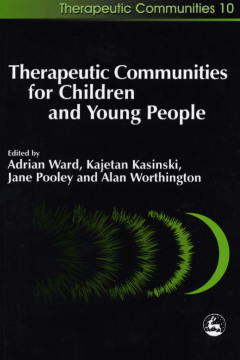
BOOK
Therapeutic Communities for Children and Young People
Kajetan Kasinski | Peter Wilson | Jane Pooley | Linnet McMahon | Alan Worthington | Adrian Ward
(2003)
Additional Information
Book Details
Abstract
Tackling the difficult issues facing those who work with traumatized and sometimes dangerous young people and their families, this new volume shows how professionals can bring about positive change and growth through the creation of "holding" and healing therapeutic environments. This collection of papers written by established and respected experts with extensive practice and research experience builds a powerful picture of the theory and practice of therapeutic community work with young people. A wide variety of therapeutic community approaches is considered alongside an analysis of the implications of this model for mainstream residential practice. Social work, health care and education professionals will find the text invaluable for its presentation of a well-founded analysis of their work with these most damaged and desperate children and young people.
This publication combines an in-depth explanation of the role and uses of therapeutic communities for traumatized and sometimes dangerous young people, with organisational and practice guidance.
Health & Care
Social workers working with young people should find this a stimulating and informative read, as should service managers and those who commission services for desperate and damaged children.
Care & Health
The book is of direct relevance to any practitioner and manager who wishes to develop a provision for children and young people which aims to provide a healing experience and bring about real recovery.
Young Minds Magazine
This is a gem of a book for anyone seeking an insight into the dynamics, dilemmas, difficulties and ultimately joys of working with young people in the therapeutic communities. This is an excellent book, well worth its weight for anyone involved in work with young people in child and family psychiatry, residential care, and in particular those at work in therapeutic communities.
Jeremy Woodcock,University of Bristol
An impressive, comprehensive collection that is badly needed to fill a gap in the current literature. The volume addresses a very highly specialized treatment-modality practiced in the United Kingdom in therapeutic communities. Yet most of what is described is familiar and useable for those of us who practice in the United States and, I would imagine, elsewhere in the western world. There are many case-specific examples to illustrate or elaborate what the authors intend to convey. I found these clear case illustrations very helpful. I would like to suggest that Therapeutic Communities for Children and Young People be placed on reading lists of professional training programs in psychiatry, psychology, social work, special education, psychiatric nursing, and child-care. Furthermore, the contents of this volume should be integrated into agency in-house training programs, which deal with this severely troubled group of young people.
Residential Treatment for Children and Youth
There is much that is new and fascinating in this book.
Child and Family Social Work
Throughout the book there is a welcome emphasis on how essential psychodynamic theory is to the provision of therapeutic experiences for traumatised children and young people. It informs an understanding of how the child's early experiences and relationships have impacted upon their development. How staff teams can process and reflect upon their work within the group and keep organisational dynamics alive in any institution…The book is of direct relevance to any practitioner and manager who wishes to develop a provision for children and young people which aims to provide a healing experience and bring about real recovery.
Young Minds Magazine
